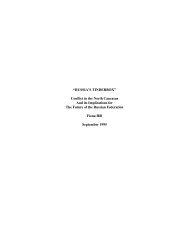Global Environmental Assessment Project - Belfer Center for ...
Global Environmental Assessment Project - Belfer Center for ...
Global Environmental Assessment Project - Belfer Center for ...
Create successful ePaper yourself
Turn your PDF publications into a flip-book with our unique Google optimized e-Paper software.
oceanic variability - constraints on this diversity from hydropower development, habitat degradation, and<br />
hatchery production serve to increase salmon mortality in the long-term, In further recognition of the<br />
habitat continuum between the ocean and freshwater environments, the NPPC highlights the need <strong>for</strong><br />
research into the role of estuarine and oceanic river plume conditions in salmon ecology. By improving<br />
conditions in the Columbia River estuary and plume to approximate pre-development characteristics,<br />
overall salmon survival should benefit as a consequence (Bisbal and McConnaha, 1998).<br />
The crisis factor<br />
While the management strategies advanced by the Northwest Power Planning Council are in a <strong>for</strong>mative<br />
stage, discussion of more radical habitat restoration on the Snake River, a major tributary to the<br />
Columbia, has reached a critical juncture. Spurred by the early 1990s Endangered Species Act listing of<br />
the four remaining Snake River salmon stocks and their continued spiral toward extinction, the breaching<br />
of four Lower Snake River dams is now considered as a viable option by federal agencies in the latest<br />
salmon recovery plans. 17 This crisis is in part prompted by the spring 2000 deadline from the Clinton<br />
administration <strong>for</strong> the Army Corps of Engineers, Bonneville Power Administration, and National Marine<br />
Fisheries Service to create a restoration plan <strong>for</strong> the endangered species (Larmer, 1999). Of course,<br />
breaching of Snake River dams is controversial, particularly <strong>for</strong> those industries that rely on the dams <strong>for</strong><br />
barge transportation and hydropower. The Columbia River Alliance, which represents aluminum, wheat<br />
growing, and other industrial interests in the Basin, argues that breaching is "unreasonable course of<br />
action" that is "economically harmful and will not an help recover salmon". 18 Industry groups argue that<br />
factors other than dams, such as over-fishing and poor oceanic conditions, exert the dominant control on<br />
salmon populations (Barker, 2000). Many environmental interests, Native American tribes, and fisheries<br />
organizations counter that breaching must occur to save the salmon from extinction (Larmer, 1999).<br />
According to one fisheries expert, "minor modifications in the system aren't working ... the dams need to<br />
be removed". The controversy has reached the highest levels of government, with both of the year 2000<br />
presidential candidates offering their opinions on whether or not the dams should be breached (Mapes,<br />
2000; Seeyle, 2000).<br />
The continued crisis of depleted salmon stocks is a major factor influencing the incorporation of abrupt<br />
climate change in<strong>for</strong>mation into the Columbia Basin salmon recovery debate. Those wishing to<br />
minimize the freshwater habitat restrictions desire more aggressive salmon conservation measures to<br />
improve the diversity and hence resilience of salmon to natural variability, while those interests that<br />
benefit directly from the dams use high oceanic salmon mortality to justify status-quo measures of<br />
juvenile salmon barging, hydropower turbine screens, and the like. The opposing views can be<br />
caricatured as follows: if ocean conditions can't be controlled, then 1) management actions in freshwater<br />
habitat must be dramatically altered to help salmon cope with variable oceanic conditions, or 2)<br />
management actions to further improve freshwater habitat are relatively futile. In the contentious<br />
environment of balancing the needs of economic development with salmon habitat preservation, it<br />
appears that knowledge of variable oceanic conditions is employed to advance existing political agendas.<br />
Inter-basin comparison<br />
While political controversy over natural resources is also a key factor in the Colorado Basin, the Severe<br />
Sustained Drought assessment lacked a crisis event comparable to that in the Pacific Northwest. Crisis<br />
often clarifies key issues and offers an opportunity to revise entrenched resource management policies,<br />
clearing the way <strong>for</strong> new approaches that were once infeasible <strong>for</strong> technical or political reasons<br />
13
















